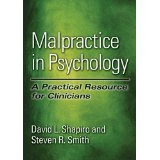Malpractice in Psychology: A Practical Resource for Clinicians

By David L. Shapiro and Steven R. Smith
American Psychological Association
Washington, D.C., 2011
‘Must read’ book is invaluable resource
Reviewed By James K. Luiselli, Ed.D., ABPP, BCBA-D
Malpractice claims against psychologists are relatively few compared to other healthcare professions but equally debilitating. There is, of course, financial threat but challenges to one’s reputation and self-esteem as well. Preventing malpractice liability demands deliberate attention to basic practice standards and implementation of risk avoidance strategies. Thankfully, this book tells how to do so and true to its title, is indeed a practical resource for clinicians.
Psychologist, David L. Shapiro, and attorney, Steven R. Smith, wrote their book, “to help psychologists understand the legal bases of liability and the reality of malpractice….and to help them take reasonable steps to limit the risk of malpractice claims.” The book is slim, 164 pages of text, but packed with essential information that is presented in nine eminently readable chapters. Some of the key topics are negligence in professional practice, confidentiality, tort actions (non-contractual civil harm), consent, privileged communication, and therapist-client relationships.
Shapiro and Smith introduce each chapter by highlighting the expected practice standard, relevant case law and examples of behaviors that increase the risk of malpractice. Readers will appreciate the no-nonsense and jargon-free writing style. All of the chapters conclude with a list of suggestions that are stated succinctly and unequivocally, for example, “Do not bend a diagnosis for managed care,” and “Never hold yourself out as having a specialization or special expertise, training or experience that you do not have.” All of the chapter recommendations are summarized later in the book.
Although Shapiro and Smith focus primarily on avoiding a malpractice claim, they do not ignore what to do if and when a psychologist is confronted with one. They explain the process of civil litigation, trial proceedings, settlement, testimonial privilege, dealing with subpoenas and related matters. Clearly, their take-home message is that having to respond to a legal complaint of malpractice is more arduous and unsettling than attending assiduously to preventive risk management.
Among many laudable features of the book, I was impressed by how well the authors were able to distill many and often complex legal concepts into reasonable practice guidelines intended to protect against malpractice liability. Really, the key is to never neglect fundamental standards of care, most notably obtaining informed consent, avoiding harmful multiple relations, maintaining confidentiality, remaining within one’s competency boundaries, not misrepresenting services and adhering to prevailing ethics codes.
This book covers them all and then some.
“Malpractice in Psychology” is must reading for psychologists, psychologists in training and other mental health professionals. Each chapter stands on its own and can be supplemented by additional readings contained in a useful reference section. The facts Shapiro and Smith present are invaluable but so too is their interpretation of them and the implications for managing risk. This is a book you should read cover-to-cover, keep nearby, and like me, recommend enthusiastically to your students, trainees, and colleagues.
James K. Luiselli, Ed.D., ABPP, BCBA, is senior vice president, applied research, clinical training and peer review at the May Institute in Norwood, Mass.
Learn more about the book: Malpractice in Psychology: A Practical Resource for Clinicians
